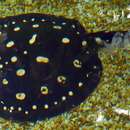en
names in breadcrumbs


The Xingu River ray, white-blotched river stingray, or polka-dot stingray (Potamotrygon leopoldi) is a species of freshwater fish in the family Potamotrygonidae. It is endemic to the Xingu River basin in Brazil and as such prefers clear waters with rocky bottoms.[1] It is sometimes kept in aquaria, like its more common relative the Motoro.[1]
The fish is named in honor of King Leopold III (1901–1983) of Belgium, who sponsored many scientific studies at the Institut Royal des Sciences Naturelles de Belgique.[3]
Potamotrygon leopoldi reaches up to 40 cm (16 in) in disc width,[4] 75 cm (30 in) in total length and 20 kg (44 lb) in weight.[5] Females grow larger than males.[6] It is closely related to the similar P. henlei from the Tocantins River basin and P. albimaculata from the Tapajós River basin.[7] Compared to P. henlei, P. leopoldi is deeper black above and its underparts are mostly brownish-dusky (large white center to underparts of P. henlei).[7][8] Compared to P. albimaculata, P. leopoldi has fewer and larger yellowish-white spots above.[7][8]
The Xingu river ray is a venomous stingray that contains venom localized at its dentine spine in its tail.[9] While the ray's venom composition does not change with maturation, the venom toxicity decreases as rays get older.[9] On the other hand, rays’ jaw shape, stiffness, and mineralization are strengthened with age, which allows mature rays the ability to consume hard-shelled invertebrates.[10] These changes in traits with maturation reflect the different pressures rays experience in terms of functions such as feeding and avoiding predation during different maturity stages.[9]
The Xingu River ray is a popular fish among monster fish hobbyists. It is known as the Black diamond stingray or BD. Captive breeding of the species have risen the captive population and occasionally bred in larger indoor breeding facilities. In the aquarium there are many different variants such as P12, Eclipse , Thousand island, etc. It could be quite expensive and the most expensive pure breeds may cost a lot. These Rays need extensive care to thrive in aquaria. They could be housed with larger fish such as Clown knife , Spotted gar , Arowana , Pacu, etc. They may live for 9-13 years under good conditions .
{{cite journal}}: CS1 maint: multiple names: authors list (link) The Xingu River ray, white-blotched river stingray, or polka-dot stingray (Potamotrygon leopoldi) is a species of freshwater fish in the family Potamotrygonidae. It is endemic to the Xingu River basin in Brazil and as such prefers clear waters with rocky bottoms. It is sometimes kept in aquaria, like its more common relative the Motoro.